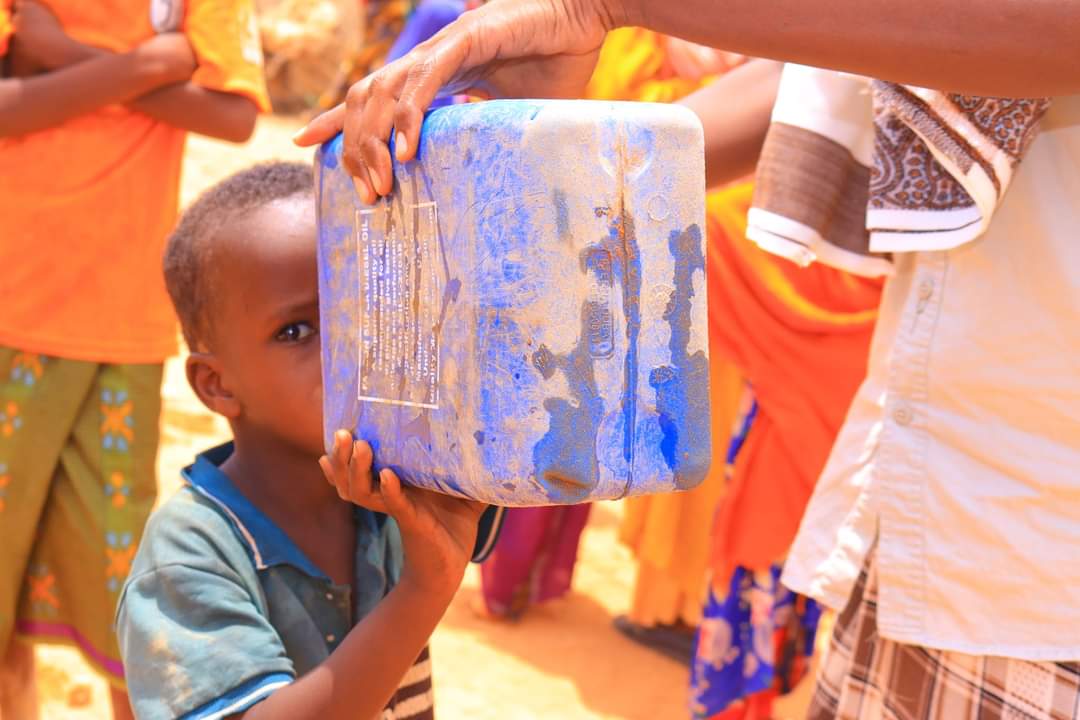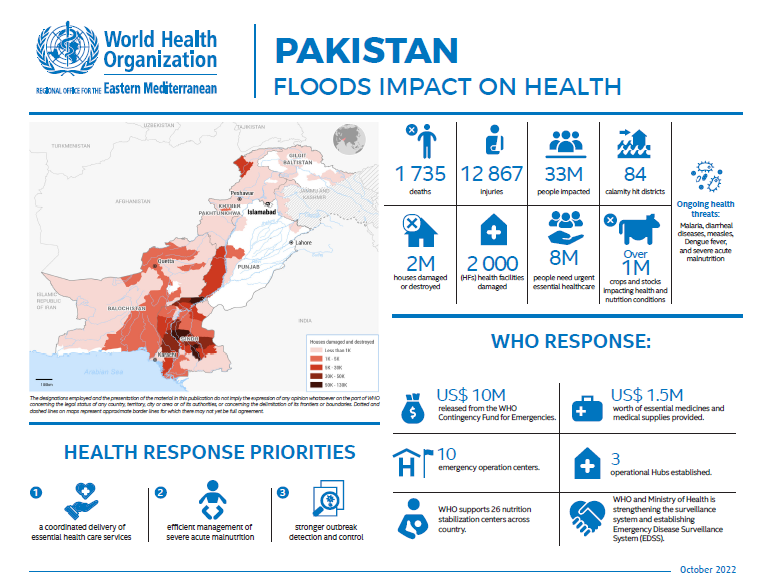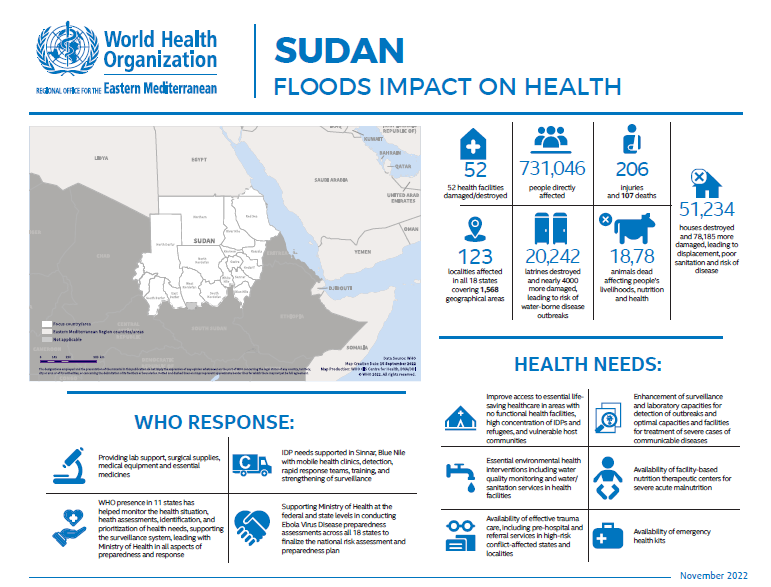2022 in focus: climate and health
Over 33 million people were affected and 7 million displaced by catastrophic floods in Pakistan
After torrential floods had devastated Pakistan, waters have started to recede in a number of affected areas over the past few weeks, but enormous volumes of persistent flood waters remain stagnant in many others.
The catastrophe has pushed the country to the brink. Around 8 million flood-affected people need health assistance, including the provision of essential medical supplies and access to basic health care. Among the biggest concerns are the high rates of severe acute malnutrition, as countless crops and stocks were also washed away.
Influxes of internally displaced populations returned to their habitats, only to face an increased risk of disease driven by damaged infrastructure, stagnant water, and inadequate sanitation facilities. Additionally, over one million houses were damaged, leaving millions helpless to face the relentless cold winter.
WHO quickly acted with its partners to deliver essential health services across various priority areas. To date, WHO has distributed medicines and emergency supplies worth US$ 1.5 million; over US$ 6 million worth of supplies is in the pipeline.
WHO scaled up its response through the establishment of 10 emergency operations centres and 3 operational hubs in Sukkur, Hyderabad and Naseerabad districts to strength the management and coordination of the overall health response. WHO also supported strengthening national disease surveillance by establishing the Emergency Disease Surveillance System in cooperation with the Ministry of National Health Services Regulations and Coordination.
Additionally, WHO worked closely with the Government of Pakistan to conduct vaccination campaigns against measles and cholera and helped ensure access to clean water through the establishment of water treatment plants.
Related link
2022 in focus: climate and health
In Somalia, famine is looming due to drought
 A child drinking stored water in an IDP camp in the Somali city of Garowe, Puntland State WHO/Mukhtar Sudani
A child drinking stored water in an IDP camp in the Somali city of Garowe, Puntland State WHO/Mukhtar Sudani
Somalia is currently facing one of the most severe droughts in its history, leading to a looming famine and the possibility of severe loss of life due to hunger, malnutrition and disease. Currently, nearly 8 million people are affected. About 3.5 million persons lack sufficient access to water, and 6 million continue to face severe food shortages – with approximately 1.4 million children suffering acute malnutrition, including 329 500 likely to become severely malnourished. In addition to the 2.5 million already displaced population, over one more million are also displaced as they search for food, water, shelter, health care and any available assistance.
Furthermore, the drought is increasing endemic-prone diseases. As of 31 October 2022, a total of 11 332 suspected cases of cholera, 15 143 cases of measles and 96 063 cases of acute diarrhoeal disease have been confirmed in drought-affected areas.
WHO Representative to Somalia Dr Mamunur Rahman Malik said that, “We are racing against time to try to prevent major outbreaks of cholera or measles. We have seen death and disease thrive during prolonged food crises. We will see more people dying from disease than from hunger and malnutrition combined if we do not act now. The cost of our inaction means that children, women and other vulnerable people will pay with their lives while we hopelessly, helplessly, witness the tragedy unfold. As we have seen during our collective emergency response operations for COVID-19, early action and delivery of high quality and evidence-based interventions can lead to protecting health and well-being, even if the health system is fragile.”
WHO has been able to reach nearly 3.3 million people – about 45% of those in need – with life-saving treatments, essential health and nutrition interventions. These services are being delivered by over 2164 community health workers, 148 mobile outreach teams, 64 stabilization centres and 280 primary health care centres in the drought-affected districts.
Related link
2022 in focus: climate and health
Sudan – where 40% of the country was flooded
With 100 localities affected in Sudan’s 18 states, 286 400 people directly hit, 16 900 houses destroyed leading to various health vulnerabilities, 43 800 houses damaged, leading to displacement with consequent poor sanitation and risk of disease, 31 health facilities damaged or destroyed, 1138 latrines damaged, leading to risk of waterborne disease outbreaks, 2150 heads of livestock lost and 12 100 feddans (5100 hectares) of agricultural lands affected, impacting livelihoods, nutrition and health, the fragile country’s situation is indescribably dire.
WHO rapidly delivered massive amounts of medicines and diagnostic kits, provided mobile clinic services, detection, rapid response team training and strengthening of surveillance. WHO also supported the operation of a stabilization centre for severe acute malnutrition, offered operational support to state Ministries of Health for coordination and implementation of preparedness and response plans, provided technical support and participated in field investigation for monkeypox outbreaks.
To monitor and mitigate the impact of the floods, WHO is supporting 39 vector surveillance sentinel sites to detect vector population and guide interventions, and effect larvae source reduction and health promotion activities for aedes mosquito control in affected states. A total of 225 211 water holding containers in 87 057 houses were inspected and managed, in addition to spraying 125 483 houses in areas with high vector indices and clustered dengue cases.
A total of 696 666 mosquito breeding sites were inspected and treated in response to an increase in the number of malaria cases.




